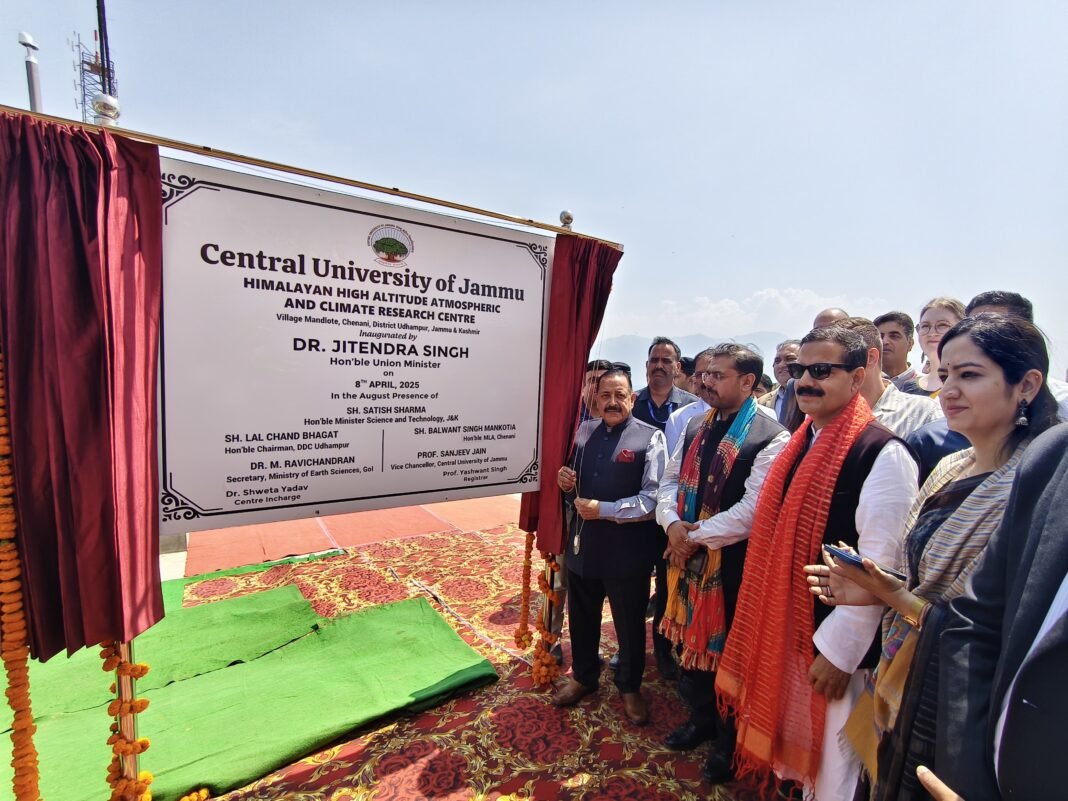Arun Jasrotia
Udhampur :DD, India opens a gateway into climate forecast and research in the Himalayas, said Union Minister of State (Independent Charge) for Science and Technology; Earth Sciences and Minister of State for PMO, Department of Atomic Energy, Department of Space, Personnel, Public Grievances and Pensions, Dr. Jitendra Singh while inaugurating the first-ever “Himalayan High Altitude Atmospheric and Climate Research Centre” in the higher hill reaches of Nathatop, near here today.
This is a move that marks a significant milestone in India’s global leadership in climate science, said the Minister, adding that Jammu & Kashmir spearheads India’s global initiative in climate study and research in the Himalayas.
The state-of-the-art facility, situated at one of the highest altitudes in the region, is expected to serve as a crucial gateway for cutting-edge climate research in the north-western Himalayas.
Coinciding with the inauguration, Dr. Jitendra Singh also flagged off the Indo-Swiss Joint Research Project “ICE-CRUNCH(Ice nucleating particles and cloud condensation nuclei properties in the North-Western Himalayas)” – a collaborative study between Indian scientists and researchers from ETH Zürich, Switzerland, aimed at exploring the properties of ice nucleating particles and cloud condensation nuclei in the region.
This is not just a scientific milestone—it is a historic moment,” Dr. Jitendra Singh said, adding, “With the setting up of this station, we are opening up a new gateway into climate research and studies in the Himalayas. And India will be pioneering it.”
The minister underscored that the choice of Jammu and Kashmir for this facility was a conscious one, leveraging its high-altitude advantage for more accurate atmospheric and climate measurements. “The implication is that J&K also joins India’s global headways in addressing the climate concerns,” he said.
Dr. Jitendra Singh reflected on how, India is now regarded seriously on the global stage in matters of climate action and research. “Today, under Prime Minister Narendra Modi, we have become a leader,” he asserted, citing India’s commitment to net-zero targets and the increasing credibility of its climate strategies worldwide.
The Nathatop centre is a product of multi-tier collaboration—between the Government of India (through the Ministry of Science & Technology), the Government of Jammu and Kashmir (which provided the land), the Central University of Jammu (whose scientists will participate in research), and the Swiss National Science Foundation (which is providing international expertise).
Calling it a “synergised model” of governance and global partnership, Dr. Jitendra Singh said this collaboration mirrors India’s broader approach to climate resilience through coordinated efforts. He cited dedicated Himalayan missions such as the Aroma Mission and the Floriculture Mission, which are unlocking the region’s potential and adding value to India’s economy.
“Preserving the Himalayas is not a regional concern but a global imperative,” Dr. Jitendra Singh said, emphasizing that the region’s vast unexplored resources could play a pivotal role in India’s future economic growth.
He also highlighted major strides taken by the government in meteorological infrastructure, including the installation of three weather radars in Jammu and Kashmir, the setting up of a seismological observatory in Udhampur, and a massive 185% hike in budgetary allocation for climate and atmospheric research under Mission Mausam.
The newly Inaugurated Centre, a joint initiative of the Ministry of Earth Sciences, the J&K Forest Department, and the Central University of Jammu, is located at an altitude of 2,250 meters above sea level. The site was strategically chosen for its clean air and minimal pollution, providing a rare opportunity to study atmospheric processes in free tropospheric conditions — a key requirement for understanding cloud formation, weather patterns, and aerosol interactions.
The Centre’s first set of measurements will be conducted under ICE-CRUNCH, bringing together Indian and Swiss scientists to study ice-nucleating particles and cloud condensation nuclei. These studies are crucial in understanding the role of aerosols in cloud microphysics and their broader implications on climate systems and precipitation in the Himalayan region.
According to experts, the Centre will serve as a long-term research hub affiliated with the World Meteorological Organization’s (WMO) Global Atmospheric Watch (GAW) Programme. In partnership with the Indian Meteorological Department, the aim is to conduct continuous atmospheric monitoring and eventually integrate data into global climate models.
Beyond scientific research, the Centre is expected to contribute to capacity building, training of young scientists, and development of climate modelling capabilities in India. It will also serve as a knowledge hub, offering training schools for students and professionals in atmospheric sciences.
As the curtains rose on this high-altitude research centre and the Indo-Swiss partnership took shape, it became clear that the Himalayas are no longer just the ‘water towers’ of Asia—they are fast becoming the nerve centre of global climate inquiry, with India leading the charge from the frontlines of Jammu and Kashmir.DD





